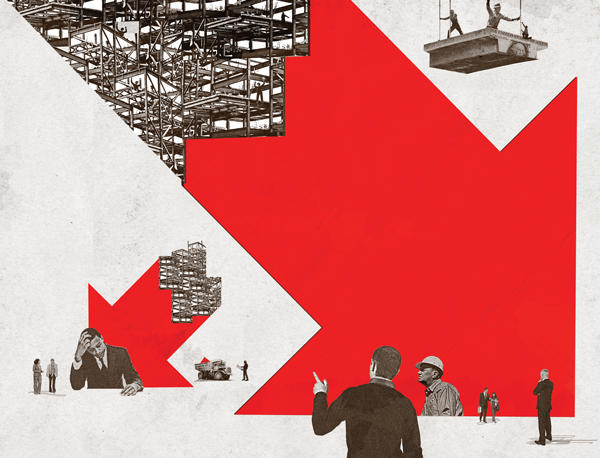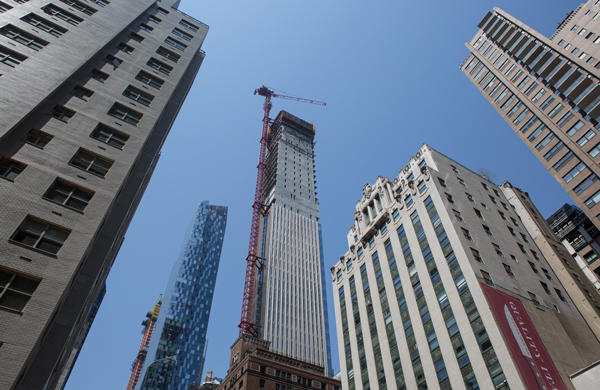Trending
Is the great real estate job boom ending?
Wages have been soaring, but automation and a growing opportunity gap spell trouble for brokers, construction workers and possibly even architects, analysts and lawyers

This spring, the British online brokerage Purplebricks landed in the Big Apple with a simple message: The city’s residential agents are making too much money.
“Our view is that in 2018 no one should be paying 5, 6 or 7 percent to sell their home, given the changing consumer behavior and access to information and viable alternatives,” Eric Eckardt, the company’s U.S. head, told The Real Deal in April. Instead, Purplebricks charges sellers a flat fee of $3,600 per listing.
The rise of the discount brokerage model — also championed by Redfin — is one of many warning signs that, after years of rising wages and employment, New York real estate’s job market may be entering leaner times.
Close to a decade of booming construction and rising property prices in the city has pushed up wages and created thousands of jobs in construction, design, building management and brokerage services.
At the end of last year, nearly 270,000 privately employed New Yorkers worked in real estate and construction, up from just over 232,000 in 2007, a TRD analysis of the U.S. Bureau of Labor Statistics’ census of employment and wages found. As factory jobs disappeared and blue-collar wages stagnated or declined nationally, the property business became one of the largest drivers of job growth post-financial crisis.
Using a broader definition of real estate employment, including retail and hospitality, the Real Estate Board of New York estimated in early 2017 that 600,000-plus jobs in New York City — with a total of $45.8 billion in wages and benefits — rely on the industry.
But increasingly, workers and industry observers worry that the boom times may be coming to an end, as automation and the decline of unions threaten jobs and suppress wages. The threat of a cyclical market downturn would also take a big toll on real estate employment. And the combined impact on New York’s economy and the future of its middle class could be profound.

Some industry sources say that shift has already started.
The years “2017 and 2018 were not as good as the years prior,” said Peter Muoio, chief economist at online real estate marketplace Ten-X Commercial. While top earners are still doing comparatively well, he added, many lesser-known brokers and other intermediaries “are hurting.”
A golden decade
Although the job market cooled slightly in 2017 and 2018, data from the BLS show that employment and wages have both risen in the past decade. Real estate employment in Manhattan grew by an annual average of 1.1 percent between 2006 and 2017, TRD’s analysis of the bureau’s survey data found.
Construction jobs in the boroughs, meanwhile, rose by an average of 2.54 percent per year. Growth was particularly strong in nonresidential construction, where the number of workers grew by 3.7 percent per year on average.
Pay in real estate and construction has also outpaced other industries — growing by 3.63 percent and 2.69 percent per year, respectively, compared to 1.96 percent for all industries combined.
Nonresidential construction workers saw average earnings of $130,360 in 2017, up from $101,391 in 2006, while earnings for residential construction workers rose to $83,669 from $63,857. Pay for specialty trade contractors rose to $91,422 from $67,323, and real estate property managers saw their earnings grow to $91,227 from $65,326 in the same period.
Real estate and construction are a “heavily blue-collar and well-paid” sector of employment, said Lawrence Mishel, a labor economist at the pro-union think tank Economic Policy Institute. “There’s not that many of those left,” he noted.
John Santos, head of the residential division at the building services union 32BJ SEIU, said the average cost of a unionized doorman in the city (a figure that includes wages and benefits) increased to $84,000 from $50,000 over the past decade. “Don’t you see a crane just about every block?” he said. “All that new construction is new jobs.”

Sectors not traditionally associated with blue-collar employment have also enjoyed strong wage growth. Earnings for real estate agents and brokers rose to $167,435 from $149,612 in the same period, though that average pay hit a peak of $181,869 in 2015 — when the commercial and luxury residential markets were both seeing record highs.
Average pay in architectural services, meanwhile, rose to $100,792 in 2017 from $79,214 in 2006, as a surge in new construction pushed up demand. The number of people working in the sector jumped to 14,822 from 11,835 over the same period.
“We hear a lot about Wall Street being a driver of jobs and economic activity, and it seems as if the real estate industry gets ignored,” said Mike Slattery, who recently stepped down as the head of REBNY’s research department.
“Real estate really is the large driver in the city’s economy,” he added. “The average wages may be higher on Wall Street, but they certainly don’t have the same level of employment.”
Growing gaps
Real estate as a job engine, however, may be less consistent than financial services. Similar to construction, employment in brokerage and leasing services is highly cyclical: Wage and job numbers are up when lots of buildings are being built, sold and leased, and they’re down when the market stalls.
So it’s hardly surprising that the number of people who work in the field has exploded over the past decade. TRD’s 2017 Data Book found that 63,142 real estate brokers and salespeople worked in the five boroughs in 2016 — up almost 20 percent from three years earlier. And average pay for agents and brokers in Manhattan stood at $167,435 at the end of last year, up from $149,612 in 2006, per BLS data.
But industry observers say these numbers mask a widening income gap: While a handful of brokers are doing very well for themselves, more and more are struggling to make a living.
“The bottom 40 percent do not even make minimum wage and are an expense to the firm that holds their license,” Andrew Heiberger, CEO of the brokerage Town Residential, which folded most of its business in April, told TRD.
One factor driving down the incomes of many agents, industry insiders say, is the “Million Dollar Listing New York” effect. The Bravo TV show, which first aired in 2012 and follows the flashy lives of Manhattan luxury real estate agents, popularized the residential brokerage industry and inspired a growing number of people to join it. But as more brokers join the business while the number of actual luxury listings stagnates amid a slowing market, every agent has fewer opportunities to make money.

“It’s ruthless right now,” said David Schlamm, head of the Manhattan brokerage City Connections Realty. “I see more and more companies struggling.”
It’s telling that since its peak in 2015, the average income of brokers and agents has fallen by 4 percent per year.
Meanwhile, brokerages are under pressure to cut commissions. The rise of discount brokerages like Purplebricks and Redfin means 6 percent commissions are harder to justify. Redfin, for example, claims it charges a mere 1.5 percent for listings, about half the typical fee. And developers can also use their bargaining power to push down commissions.
In the commercial brokerage industry, the income gap between top brokers — who can rely on big clients in good and bad times — and everyone else is also widening amid a weak market, said Michael Weiser, president of GFI Realty.
“The top guys are down, but they’re not down as much as the market,” he said. “The rest, they’re hurting big time.”
The union effect
If the picture is mixed for agents and brokers, observers say construction workers have generally done well over the past decade. One plausible explanation for the strong wage growth is that many of those jobs are highly specialized, require extensive training and command a skill premium when demand for their services spikes.
“The labor pool hasn’t expanded in a big way,” said Jonathan Bowles, executive director of the think tank Center for an Urban Future.
The biggest factor driving up blue-collar pay in the real estate industry, however, is union density. In New York City, 31.5 percent of construction workers and 25.8 percent of building and security services employees are union members, compared to 14.6 percent and 4.7 percent nationally, according to a 2017 report by Ruth Milkman and Stephanie Luce of the City University of New York’s Joseph S. Murphy Institute.

The under-construction 111 West 57th Street, where a mix of union and nonunion labor is being used.
Nonunion workers also tend to enjoy higher wages if more of their peers are organized. In a 2016 study, a group of sociologists at Washington University in St. Louis argued that average wages of male nonunion workers across all industries would be 5 percent higher if union density were as high as it was in the 1970s.
In construction, the share of unionized workers around the country has fallen by about two-thirds since 1973, while annual pay is about $10,000 lower in real terms, Jake Rosenfeld, one of the Washington University sociologists, told TRD.
For a sense of how New York’s strong union density impacts wages, consider WeWork.
As the fast-growing startup expanded across Manhattan in its early years — raising millions from venture capital firms at eye-popping valuations — its custodial workers, employed by a contractor, reportedly earned as little as $10 an hour. In June 2015, 32BJ began protesting outside the company’s then-headquarters in the Financial District, demanding better working conditions.
Following a months-long standoff that threatened WeWork’s self-declared image as a do-good company, the co-working giant agreed to start hiring its custodial workers directly and paying them the union wage of $23 per hour — a 130 percent increase.
The company also promised to work with union contractors “wherever possible.”
“Building services in New York, because it’s heavily unionized, actually provides some decent jobs,” the Economic Policy Institute’s Mishel said. “[The industry’s] not necessarily known for doing so across the country.”
But if organized labor is one of the main reasons blue-collar workers in real estate and construction have seen rising living standards over the past decade, the gradual decline in union dominance should be major cause for concern.
Even in construction, unionization is low by historical standards — particularly in luxury residential development. New York developer Michael Stern made headlines in 2015 when he and his partners started building the 1,428-foot condo tower 111 West 57th Street with a mix of union and nonunion labor. Although nonunion workers have long been used in residential construction, Stern was widely credited as being the first developer to build a complex, supertall skyscraper using nonunion labor.
Other developers are now looking to follow suit.
It’s “safe to say that continuing declines in unionization in construction and elsewhere make it more likely that a strong economy may not lead to real pay gains for average workers,” Washington University’s Rosenfeld said.
One 29-year old doorman, who spoke on the condition of anonymity, is another example of how declining union membership could change the labor market: He works 40 hours a week at a luxury rental building in Downtown Brooklyn where one-bedroom apartments go for more than $3,000 a month. That nonunion job pays him $32,000 per year.
When he got his first job as a doorman 11 years ago — at a large apartment building on the Upper West Side — he said he was making $48,000 per year. That job was unionized.
The doorman said he looked for union employment before taking his current job about three months ago but couldn’t find any available work. “Union jobs are tough to get into,” he noted. “People who are in this industry generally don’t leave.”
Virtual replacements
Shrinking unions aren’t the only threat to workers. A jarring 85 percent of the 5.6 million manufacturing jobs the U.S. lost between 2000 and 2010 vanished due to technological changes and automation, according to Ball State University’s Center for Business and Economic Research.
Compared to those in car manufacturing, construction and building services workers have been lucky: Their industries continue to be highly labor-intensive, and robots are still a rarity.
But that’s starting to change.
Companies like Google’s Nest sell smart-door software that handle some of the core tasks doormen do, such as verifying the identity of visitors and receiving packages. Meanwhile, blockchain technology, machine-driven algorithms, and smart contracts — which can be enforced and verified by machine-learning technology — could put some real estate brokers, analysts and even attorneys out of business.
Unlike in blue-collar jobs, where the threat from automation is more immediate, observers are more skeptical that technology will replace humans in white-collar jobs anytime soon.
Michael Sroka, CEO of the commercial real estate deal management platform Dealpath, said most technology is meant to help professionals, not replace them. And the history of technological innovation over the past two decades indicates that brokers, lawyers and analysts have little to worry about, he added.
“When we moved from handwritten analysis to leveraging computers and spreadsheets, it didn’t reduce the number of professionals or time spent working — it just facilitated smarter work,” he said. “The notion that online marketplaces are already a threat to brokers is overblown. Listing services, marketplaces and other platforms can’t replace the value of strategic advisers who are experts in a geographic area, product type or legal domain.”
But even if technology won’t replace people, it could make it harder for some to make money. The rise of listing sites like StreetEasy, for example, means agents are becoming less important as arbiters of information. Apartment hunters no longer need a broker to find listings, since the vast majority are available online, and rental landlords are less reliant on agents.
“Most landlords advertise directly on StreetEasy, and it’s cutting into brokers’ business,” Schlamm of City Connections noted. He added that brokers representing tenants are also under pressure to cut fees.
“Anyone saying they’re getting 15 percent on a consistent basis is lying,” he said.
The age of automation
In construction, robots can now lay up to 1,000 bricks per hour and could soon appear on more development sites. At Related Companies’ 30 Hudson Yards, for instance, a demolition robot was used to remove old structures this year.
And that may just be the tip of the iceberg. Construction, painting and maintenance are among the 25 largest industries in New York with a high automation potential, according to a recent Center for an Urban Future report.
One reason robots have not been widely adopted in construction to date is that job sites can be highly unpredictable. They can be rainy or windy, obstacles can appear at any moment, and every development project is different. And unlike human workers, robots still lack the intelligence necessary to navigate those kinds of environments.
But prefabricated construction — where building parts get assembled in factories — could make that less of an obstacle, Carl Benedikt Frey and Michael Osborne of Oxford University argued in a 2013 paper. “Prefabrication will allow a growing share of construction work to be performed under controlled conditions in factories, which partly eliminates task variability,” they wrote. “This trend is likely to drive the computerization of construction work.”
Automation may not immediately depress wages, since rising productivity should increase pay — in theory. But it could certainly lead to job loss. How many jobs will disappear in the next decade is hard to predict, and estimates widely vary.
Santos, of 32BJ, for one, dismissed the suggestion that virtual doormen could ever replace people. “In truth, people want to see the faces at the door,” he said. “They can’t call a virtual handyman to fix their apartment.”
The Economic Policy Institute’s Mishel acknowledged that technological change will likely kill jobs but emphasized that it also creates new work — especially in fields like software engineering or machine handling.
The challenge, he said, is to make sure that those gigs pay as well as unionized construction and building services work does.
“If you’re concerned about automation, then what you really should be concerned about is that we make sure the jobs being created are good jobs,” Mishel said, noting that innovations in technology can’t be stopped. “I don’t have the urge to outlaw bulldozers and hand people shovels.
Correction: An earlier version of this story misreported that Purplebricks charges a flat fee of $3,200. On July 1, the online discount brokerage raised its fee to $3,600.




